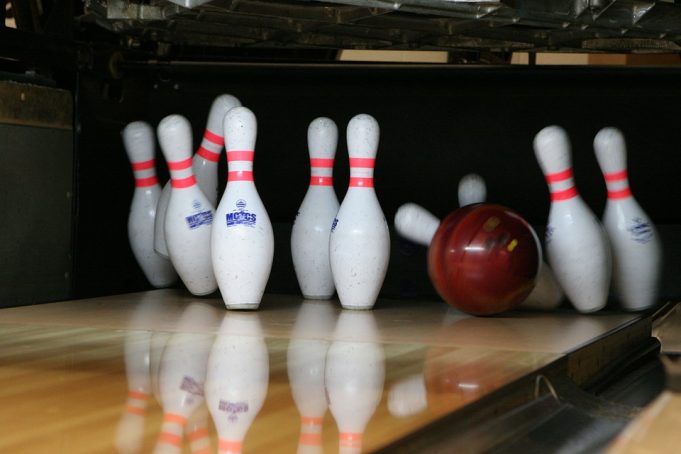“Let’s go bowling!” That’s become the rallying cry of almost thirty million Americans throughout the United States who take their exercise in extremely palatable form: rolling a hard rubber ball down sixty feet of maple and pine toward ten standing pins. Today nearly everybody bowls – mother, dad, the kids – the whole family.
Though bowling can trace its beginnings in this country to the time of the earliest colonists in Massachusetts, it wasn’t until the last decade that the sport began to boom. A number of events triggered its rebirth. The first was the introduction, in 1952, of the American Machine & Foundry Company’s Automatic Pinspotter – the remarkable device that resets the pins, announces which ones are knocked down and returns the ball – all automatically.
By replacing the often unreliable pinboy, it thereby made bowling an attractive investment for the entrepreneur. Million dollar bowling centers began to spring up in every section of the country.
And people were waiting for these centers because another factor had whetted their appetite for the sport. That was television. The type of competition bowling offers lends itself remarkably well to TV. Scores and scores of locally originated television programs as well as several full network productions introduced bowling to millions upon millions of Americans who had never been exposed to the fun of knocking down the stubborn tenpins.
Today, nearly thirty million Americans bowl regularly. Of these, approximately ten million are women; one and a half million are children. And there are more than a million new bowlers who take up the sport each year.
Bowling knows no bounds; anyone, at any stage of life, can become its devotee. The handicapped, sometimes even the blind, find fun in the sport. It can be played at any time of the day or night, at any time of the year, and in every section of the country. No other sport qualifies as well for a claim to the title of “national pastime.”
Bowling, like any other sport, has a set of do’s and don’ts that must be followed so that all can enjoy the game. The rules are based on common sense, and express courtesy and good sportsmanship.
Here are ten of the most important ones:
DO yield the “right of way.” When two bowlers are on adjacent lanes, and simultaneously ready to bowl, the bowler on the right delivers first. The other bowler ought to remain off or to the rear of the approach area. This rule doesn’t apply if the bowler on the left is shooting for a spare.
DON’T take a practice swing with your bowling ball on the concourse or behind the approach. Wait until you are up on the approach itself before doing any practice exercises.
DO be ready when it’s your turn to bowl. Remain in your lane area while your teammates are bowling; don’t wander off.
DON’T use an excessive amount of body gyrations at the foul line after delivering the ball. Confine your body “English” to your own lane.
DO bowl immediately when it is your turn. Once you have your ball, assume your stance and start your delivery; it isn’t necessary to wait for lanes on either side of you to be cleared before you bowl – just observe the “right of way” rule.
DON’T bring food or drink into the settee or bowlers’ area. A drop of liquid or any type of foreign substance spilled on the approach could cause a slip and serious injury.
DO wait until you have completed the frame before checking your score. Don’t come back to the scorekeeper after the first ball has been rolled.
DON’T bench jockey while others are bowling. Friendly bantering is an accepted part of the sport, but don’t overdo it. Be a good competitor.
DO return your bowling shoes to the counter control desk after bowling, and if you’ve borrowed a “house ball,” return it to the storage rack.
DON’T linger at the foul line after releasing the ball. As soon as your ball hits the pins return to your seat.
Now you know the etiquette, you will be welcome in any game.
About the Author
Step-By-Step Bowling Ball Drilling System Guaranteed To Improve Your Game!
Click here for FREE online ebook!




















